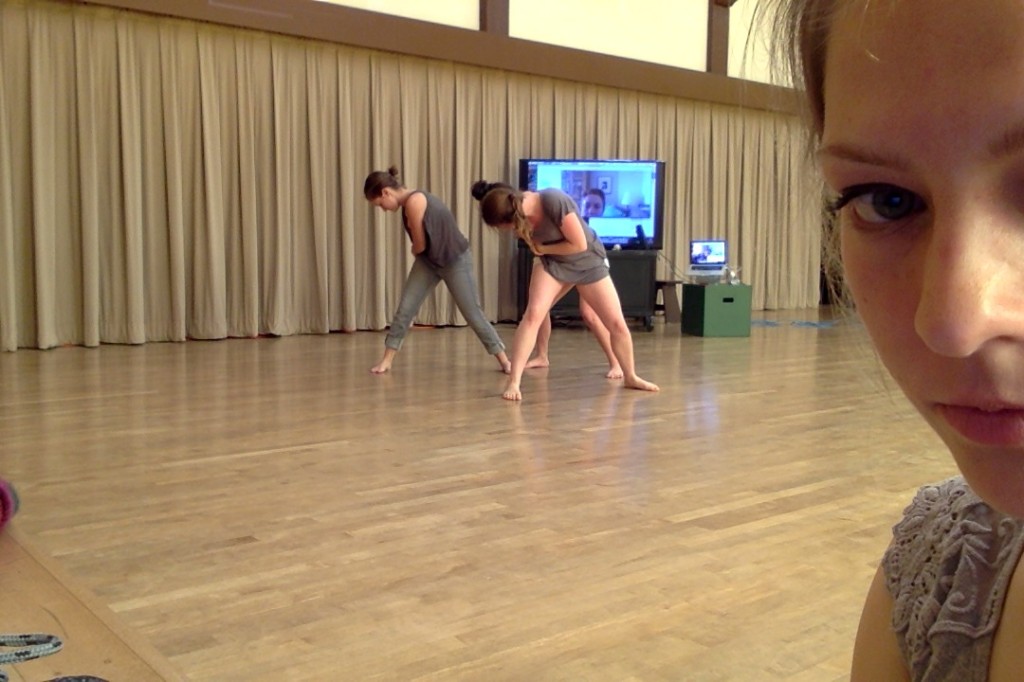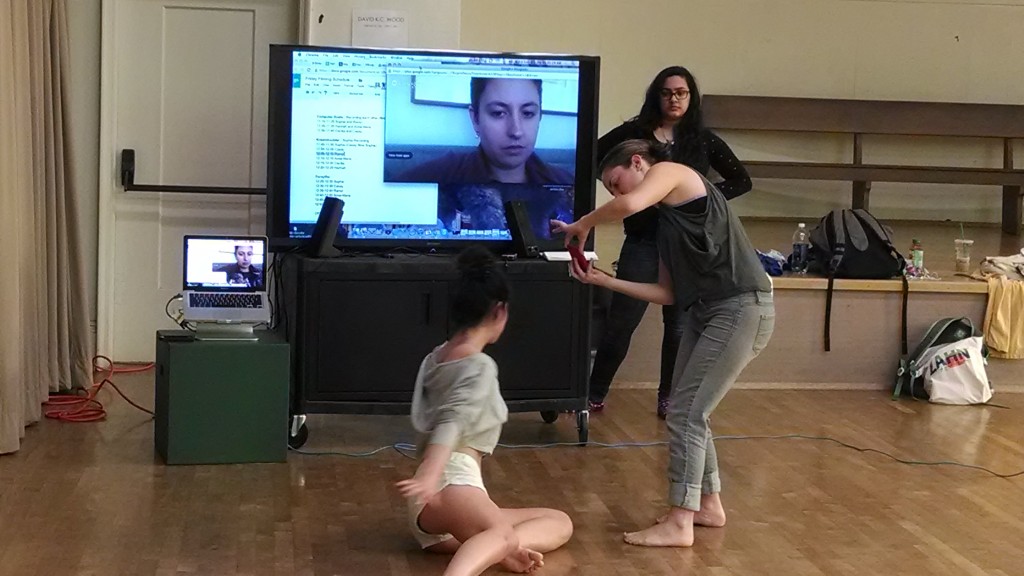
For the past year, I have been working on a new choreography that premiered this past April 17-26 as a part of the annual Berkeley Dance Project (BDP) directed by Lisa Wymore for the Department of Theater, Dance and Performance Studies at the University of California, Berkeley. I remotely choreographed the composition, entitled MOOCing?, for the Berkeley Practicum for Advanced Modern Dancers. This course is the performance requirement for dance majors at Berkeley, so the piece was choreographed in a college course setting with student dancers. As I am currently living and working from New York City and the dancers were all students at Berkeley, we were not physically together during the making of MOOCing? and used an online instruction format to compose the dance. The dance began as an investigation into the increasingly popular presence of online instruction and distance learning in institutions of higher education – hence the title’s questioning of the current fad for “massive open online courses,” or MOOCs. After a three-month remote rehearsal process with dancers who I had never met, MOOCing? was presented in a traditional live Western concert stage performance.
As a PhD candidate at UC Berkeley who teaches undergraduate courses in dance and in art practice, I was curious how online learning might hinder, change or strengthen arts education – in particular, instructions in live performance. My inquiry into this topic began in 2012 when, with support from a HASTAC/MacArthur Foundation Digital Media and Learning research grant, I collaborated with colleague Reginold Royston to design an online art practice course titled “American Cybercultures” for Berkeley art practice professor Greg Nieymer. We set out to research and develop collaborative methods for preserving process-based arts instruction within the format of online learning. In our research, I came across questions about liveness, presence and absence in online learning. Is it important for students to have live interaction with an instructor? What about with their peers? Might synchronous interactions via remote technologies be sufficient for engaged learning practices, or is it necessary to share the same physical space as ones’ collaborators? As a choreographer interested in dance and technology, many of these questions resembled those that I asked in my dance work, and are questions that performance and dance scholars such as Philip Auslander, Peggy Phelan, Susan Kozel and Johannes Birringer have researched thoroughly. The resonance between dance and online learning inspired me to compose MOOCing?
I proceeded to choreograph MOOCing? in an online classroom setting, but with an acute awareness of the political problems with online instruction in dance. These issues include, but are not limited to: preserving the need for physical rehearsal and performance spaces that dance and performance departments fight very hard to gain and maintain access to; the necessity for live dance classes where instructors are able to give physical corrections; a need for process-based development of artwork that does not fit into a pre-recorded lecture model for online learning; and the importance of undergraduate dance students learning to perform in a live ensemble where they learn to share weight and contact in physical performance settings. I designed a hybrid on-land and online classroom format to respect the potential problematic of online learning in dance as well as to gear my course structure to the end goal of a traditional live performance.

The process began when I participated in the live BPD audition. I skyped into the onland audition while students gathered in the same physical studio space. I watched the audition from a web camera and my Skype image was projected on a large screen with my voice plugged into the room sound system. From my position in the video chat I led structured improvisation exercises. For rehearsals, the dancers participated in synchronous rehearsals with me over video chat. On Monday evenings the entire cast met remotely using Google hangout. It was important to me that we use relatively ubiquitous and open technologies that the students had access to in their daily lives. Each cast member participated from distinct physical locations with the entire rehearsal conducted online. Sometimes we met as an ensemble and other nights the dancers met in breakout video chats to develop duets or trios while I moved from group to group joining different chats as the rehearsal progressed. We also held one-on-one sessions between each dancer and myself so that we could get to know one another better. On Wednesdays and Fridays the cast met on-land with myself participating remotely through Skype. In the studio, the cast worked on the physical spacing and contact that was necessary for the final performance. For these rehearsals we connected Skype to a large LCD screen so that the dancers could see my image from across the studio. Our stage manager would also help by turning the web camera from side to side in order for me to be able to view movement in the entire space. The cast also participated in asynchronous online interactions such as a blog (moocingbdp.wordpress.com), a twitter account (@moocingbdp), and a self-titled facebook page. I also Skyped into group design meetings and individually met designers over video chat to design the set, costumes and lighting for MOOCing? Finally, I flew to Berkeley for the week of tech and dress rehearsals and for the opening night performance. This way, I would have access to the physical stage, set and video equipment that was all necessary to accommodate traditional live stage mechanics.
I expected for all of the technology to fail miserably throughout the rehearsal process of MOOCing? In fact, I counted on this as a part of the conceptual content of our piece. I anticipated that we would explore the technical glitch, frustrations with being kicked out of chats, and long unproductive pauses in rehearsals when we had to try and fix broken connections. Surprisingly, the technology worked relatively seamlessly. The dancers could see and hear me and I could see and hear them. There were minor inconveniences such as when the dancers were together in the studio I had trouble distinguishing their comments when they all spoke at once, so I asked them to speak one at a time. I also had trouble reading micro-expressions that would have otherwise let me know when the students understood instruction. To strengthen my ability to interact with the group the dancers would flash thumbs up or collectively jump up and down to show me that they heard and understood my direction.
Pedagogically, the greatest challenge of the project fell on my inability to share the same physical space as my students. I felt left out of the physical rehearsals. I could tell when something happened outside of the field of my camera because the cast would look to the side of the room, or giggle and begin a conversation about something that I didn’t understand. The students took on more responsibility to keep the focus of the group in the physical rehearsals when I did not have access to room activity. My dancers have also expressed how it took longer for them to trust me as a choreographer because they were less sure of what to expect from someone they had never met in person. Surprisingly, Monday evening online rehearsals proved more effective than the hybrid on-land/online rehearsals because on Mondays everyone was together in the same medium. I had the dancers’ full attention and I could hear them much more clearly. While the students often missed having physical contact with one another in this format, they too felt a deeper connection to me on Monday nights when we all shared the mode of video chat. This is where we built trust and shared similar spatial and temporal relations, allowing me to lead the group more easily as an instructor. Physical rehearsals were still incredibly important for the dancers, as this was where we set the spacing of the choreography. We gained from one format what the other format lost.
The movement content for MOOCing? came from our experience building trust, exploring lines of communication, and articulating the privilege of having access to online communication and physical interaction. MOOCing?? incorporated platforms to signify the distinct spaces that MOOCing? participants occupied over the course of our remote collaboration. We used string that connected the dancers in space and made visible the otherwise invisible connection between bodies that were staged far apart from one another. When one body moved, the ripple in the string would affect another body across the space thereby representing the visceral connection that we all felt in our remote collaborations. A projection screen designed in relation to the size of bodies moved around the stage on casters to show the dynamics of screen-based interaction, just as my dancers experienced when they danced with their laptops through their family homes, fraternity houses and dorm rooms.
Movement motifs including stillness, staring, tension, physical contact or lack thereof, and repetition drove the narrative arc of MOOCing? Each motif was inspired by the remote rehearsal process, but came to signify the individuality of the cast as the dancers related an articulation of these topics to their own lives. Each dancer honed specificity in their movement in order to exude presence when they had trouble expressing it through mediated communication. The cast independently sculpted the details of each movement when the performance landed beyond the scope of the web camera and I was unable to dictate specificity.
When I arrived in person for the first time on April 7, I was touched to find a live dance in which each performer exuded his or her own relationship to presence and liveness. They did not dance the same because they did not always have access to their choreographer or each others’ bodies. Nor were they entirely distinct because they overcompensated for a lack of physical contact with openness to letting each other in and patience with building trust. Anne-Marie Balke, Casey Flores, Ramzi Jneid, Sophie Needelman, Cecilia Vasquez and Hannah Westbrook found a grounded and particular place on the Internet. They illustrated that while dancing online and apart from one another poses obstacles and is by no means always the preferred way of moving, the experience of making process-based work in online space does not have to dictate placelessness and absence. In fact, after collaborating with my dancers on MOOCing? I wonder if making a dance online challenges students to develop presence and communication in dancing – the same qualities that I expected to fail in this experiment.
This article appeared in the June 2014 issue of In Dance.


